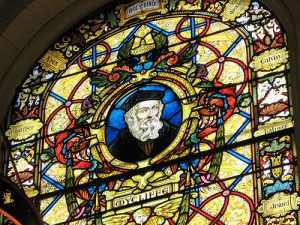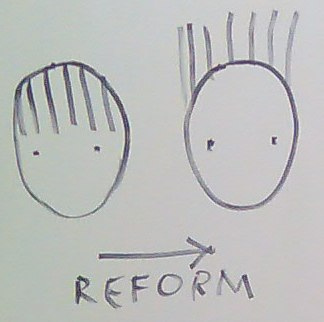Reformation Sunday/23rd Sunday after Pentecost
October 27, 2013
How lovely is your dwelling place, O Lord of hosts! My soul longs, indeed it faints for the courts of the Lord; my heart and my flesh sing for joy to the living God. Psalm 84:1-2
Whether the church you serve and/or attend finds its roots in the Reformation, the truth is that the Church in all its diversity is rooted in reformation. Yes, the message–the good news of Jesus Christ–is the same in every age, but how it finds its expression and its practice is deeply rooted in context and therefore constantly re-forming. The world around us changes. We either re-form for the sake of the gospel, or we entrench in the security of our traditions and assumptions. We must constantly explore new and fresh ways to share the good news, employ effective ways of catechizing and incorporating folks into our communities of faith, and retool our approaches to ministry and mission.
For example, no one would think of dragging out the 16mm projector to show a Luther film this weekend. Most of us probably don’t even have a  VCR anymore. It’s quite possible that we might use that DVD, but some folks would choose to upload the movie to their laptops and project it–quite possibly from YouTube, Netflix, or Hulu Plus. Gutenberg is giving way to Google whether we like or loathe it. And just look how much mobile phones have changed! We’ve come a long way from Ma Bell’s party line. The principles and the content are fairly constant, but the delivery is changing with increased frequency. Most of us willingly “re-form” how we view media and make contact with one another, yet we tend to resist change in the church.
VCR anymore. It’s quite possible that we might use that DVD, but some folks would choose to upload the movie to their laptops and project it–quite possibly from YouTube, Netflix, or Hulu Plus. Gutenberg is giving way to Google whether we like or loathe it. And just look how much mobile phones have changed! We’ve come a long way from Ma Bell’s party line. The principles and the content are fairly constant, but the delivery is changing with increased frequency. Most of us willingly “re-form” how we view media and make contact with one another, yet we tend to resist change in the church.
Instead of celebrating the Reformation as a landmark, as history, or as foundational to your denomination’s character and theology, why not celebrate the very real fact that the Church is a living, breathing organism that (gulp) changes and reforms. I don’t know about you, but I’d sure prefer to be a part of something alive than something lifeless and non-responsive. Besides that, just take a walk through scripture and look at the holy mashup of folks God uses to accomplish the divine purpose. Of course, there’s also the fact that the Bible is a mashup of different books representing different times, places, situations, and  people all dedicated to the same life-affirming, live-giving, and salvific story of God’s relationship with humankind and, indeed, all of creation.
people all dedicated to the same life-affirming, live-giving, and salvific story of God’s relationship with humankind and, indeed, all of creation.
Re-formation among the faithful has been a reality long before the Protestant Reformation became big news, it has not stopped, and it seems unlikely to do so any time soon. So hop on the Re-formation train for the entire journey–not just a narrow slice of history. Celebrate the goodness of God, the amazing message of which we are stewards, and the myriad ways the church has and continues to reform.
In celebration I bring you a short “mashup” of the lessons appointed both for Reformation Sunday and for the 23rd Sunday after Pentecost. Any one of these lessons can be the springboard for your celebration of God’s reforming, renewing, and restoring work–past and future to be sure–but particularly right now in your time and your place. I wish you joy, peace, and vision as you prepare for your worship!
Reformation Sunday Lessons
Jeremiah 31:31-34: Three words–Hope. Amnesia. Gumby. We have hope in a God who chooses not to remember and who never breaks the covenant. Our God is amazingly flexible with a bunch of stiff-necked followers!
Psalm 46: Be still. Be not afraid. God is in the house, so offer your best praise. Enough said.
Romans 3:19-28: Salvation is a gift we cannot earn. It is gift. Plain and simple. Thank you, Jesus!
John 8:31-36: Want to be free? Want a real forever kind of home? Stick with Jesus.
23rd Sunday after Pentecost Lessons
Jeremiah 14:7-10, 19-22: We sin; God saves. God is present among us, and God is our hope.
Psalm 84:1-7: God is our home and our joy. Sing praises and give thanks to God.
2 Timothy 4:6-8, 16-18: God is the strength of the faithful and enables us to persevere.
Luke 18:9-14: Don’t be getting uppity and overconfident. Beware of high horses. It’s about God, not us–and that’s a very good thing indeed.
Truly, the constant thread runs throughout. God is gracious, merciful, and desires to save. God is with us. We are called to center our lives in God, to worship and offer praise and thanksgiving. When we stick with the Lord, we are free to be, to love, and to give. Amen.
In Worship
The hymn “God is Here” is a good one to remind us of the constant in our faith that is never in need of reform. Pay particular attention to the fourth verse where it says “help us work your purpose out.” In that working we reform the church for each age, yet God is constant. How might we help people live in the tension of that which never changes and that which ever-changes? It is important to honor the reality that change is often hard but still is necessary.
With Youth
How does one explain freedom in Christ to youth who have never “known” slavery, who have lived in relative safety, comfort, and freedom? Hint: Head to the font and remind them of the words we use in confession: “We are in bondage to sin and cannot free ourselves.” Our freedom comes in Christ, in living for, in, and with the Word of God made flesh. Consider reviewing the lesson from 2 Timothy if you are using the 23rd Sunday after Pentecost lesson or John 8:31-36 if you are using the Reformation lessons. How do we see that freedom played out in our daily life? Does freedom also imply accountability? If yes, where do we find that accountability? How does the community of believers play into our freedom in Christ? You should find some rich connections for faith strengthening in these lessons, and youth never fail to amaze and inform.
With Children
Clay-formation
Purchase small party-size packages of Play-Doh. Find pictures of various church reformers throughout the ages, and copy them so that you can cut a small circle to fit in the inset of the lid. You might end up with images of Luther, Zwingli, Calvin, Melanchthon, Pope Francis, the Wesleys, Oscar Romero, and Desmond Tutu, for example. Invite the children to open their Play-Doh. Ask them if the Play-Dohs are all the same? No. They are different colors. Can you bend and mold the Play-Doh into different shapes? Yes! Can you blend different colors together to make something new? Yes! Can you let it dry up? Yes. Can you press it back into its container and keep it fresh and ready to use again? Yes. So Play-Doh is remarkably flexible and versatile. Is it still Play-Doh? Of course! That fact doesn’t change no matter what color it is, what shape it is molded into, or how it’s blended together.
The gospel of Jesus is like that, too. It is always the same good news–no matter what color, what shape, or anything else. Our churches may change throughout the age, and there are many reformers like the ones on the Play-Doh covers who have reshaped and reformed the church over the course of history, but our good news is always constant. Although our reformers come from different times and traditions, the good news they bear to the world is always true and never changes. And that is very good news indeed!
Photos: Rene Clausen Nielsen, Pam Drenner, and Randy OHC, Creative Commons.




Great children’s sermon idea. I’m using it! Thanks!
Glad you found it helpful, Pastor Amborn. Blessings on your worship this week and always! God is good.
Not just for children…the clay/playdough idea is great for the entire worshipping community! Thanks!
Thank you, Pastor Roser!